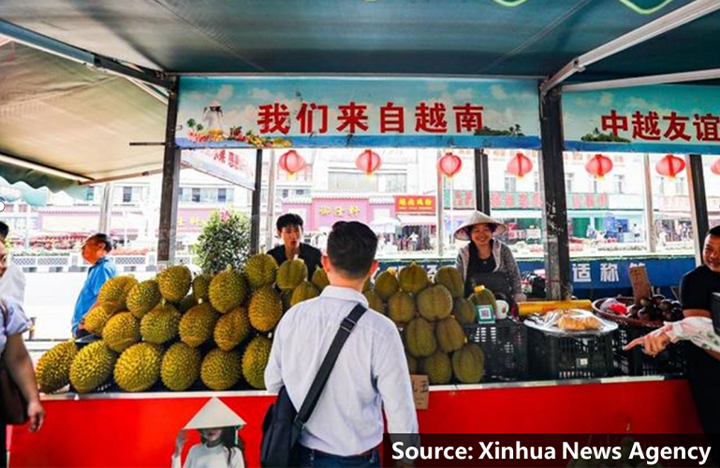



On May 18, 2023, in Dongxing, Guangxi, Vietnamese fruit merchants are selling durians. Source: Xinhua News Agency
This year marks the 15th anniversary of the comprehensive strategic partnership between China and Vietnam. Over the past fifteen years, both countries have been consistently promoting regional economic integration, supporting enterprises in cross-border e-commerce, digital economy, green development, and other strategic and emerging areas of cooperation. This has led to robust growth in Sino-Vietnamese trade, yielding fruitful results. Official data indicates that Vietnam has consistently been China's largest trading partner in the Association of Southeast Asian Nations (ASEAN) and the fourth-largest global trading partner over the years.
With proactive trade policies and the unique advantage of geographical proximity, China and Vietnam have achieved a series of successes in trade this year. In the first eleven months of this year, the trade volume between China and Vietnam reached 1.45 trillion yuan, a year-on-year increase of 3.6%. According to data released by the General Administration of Customs of China, the bilateral import and export volume reached a monthly record of 161.92 billion yuan in November alone, a year-on-year increase of 12.5%, reaching a historic high for the month. In the first eleven months of 2023, the total import and export of intermediate products between the two countries amounted to 1.01 trillion yuan, accounting for 69.8% of the total trade between the two nations.
Both China and Vietnam are staunch supporters of free trade and are committed to promoting economic globalization. For instance, both countries are signatories to the Regional Comprehensive Economic Partnership (RCEP), highlighting their dedication to establishing an open, rule-based trading system. It is under the support of these similar trade principles that rapid development has been witnessed in trade between the two countries, especially drawing extensive discussions and attention internationally regarding their border trade. The prosperity of Sino-Vietnamese border trade is attributed to a series of advantages, including the convenient geographical location provided by their adjacency, continuous improvement of infrastructure, and the formation of product complementarity.
Border trade, as a highlight of Sino-Vietnamese trade, has seen significant development in recent years, with both countries actively promoting its growth. For example, Dongxing, a county-level city in the Guangxi Zhuang Autonomous Region of China, is the only port city with both sea and land connections to Vietnam. In recent years, Dongxing has played a crucial role in Sino-Vietnamese border trade. Mong Cai is the most economically promising region in northern Vietnam. On November 30, the 15th China-Vietnam (Mong Cai-Dongxing) International Trade and Tourism Expo was successfully held, showcasing the vibrancy of Sino-Vietnamese border trade.
The contiguous border between China and Vietnam creates extensive opportunities for economic and trade cooperation between the two countries. With a total land border length of over 1,300 kilometers, spanning multiple provinces in northern Vietnam, it provides a significant advantage in promoting trade, especially border trade. Due to their close geographical proximity, both countries have established numerous border trade points, stimulating the creation of new trade growth points, facilitating the flow of goods, and promoting bilateral economic exchanges. At the same time, the shared border has also saved a considerable amount of distance-related costs for bilateral trade. For those living in the border areas of both China and Vietnam, trading with each other is akin to conducting transactions with a city within their own country.
Simultaneously, the development of border trade between China and Vietnam is inseparable from the improvement of infrastructure in both countries. In recent years, both China and Vietnam have placed high importance on port renovations to enhance customs efficiency. Cross-border ports between the two countries are connected by highways, and China's high-speed rail has extended to the Vietnamese border city. Relevant transportation departments are optimizing and upgrading transportation facilities, increasing transport capacity, thus reducing transportation costs and improving efficiency.
Another crucial factor contributing to the continuous development of border trade between the two countries is the complementary nature of their respective products. In recent years, a notable aspect of Sino-Vietnamese bilateral trade is the flourishing cross-border fruit trade. According to relevant statistics, China's exports of agricultural products to Vietnam reached 34.31 billion yuan in the first eleven months, a year-on-year increase of 3.1%. Vietnamese vegetables and fruits, in particular, are highly popular among Chinese consumers. For example, durians and grapes from Vietnam have become common fruits in many Chinese households. Thanks to rapid transportation, cold chain logistics, and the development of e-commerce, Vietnam's fruit exports to China have seen substantial annual growth. Chongzuo City in Guangxi, located on the Sino-Vietnamese border, has become China's largest city for border fruit imports and exports.
Fundamentally, the development of Sino-Vietnamese border trade is a result of adhering to the shared principles of openness and cooperation in trade and continually keeping pace with emerging trends, heavily investing in infrastructure, and embracing the inevitable trend of e-commerce development.
Source: <https://baijiahao.baidu.com/s?id=1785161996132154713&wfr=spider&for=pc>
Edited and Translated by Li Wei